The Kimberley Toad Busters Achievements in a Nutshell
It became evident, from the very beginnings of the establishment of the Kimberley Toad Busters, that it had triggered a response within the community not witnessed in Kununurra for a very long time, if ever. It was also evident that cultural boundaries had been ‘traversed’ in a way not witnessed before by the participants. The campaign has became a true ‘community campaign’, not just an individual issue with enormous and unanticipated positive social outcomes as well as the positive economic and environmental outcomes, thus being quite properly described as promoting sustainability in our community.
1.4 Kimberley Toad Buster Outcomes to Date
- Unique program established, continuing and growing – learning as we go
- 7 Toad Busting Leadership Training exercises undertaken at the cane toad front since September 2005
- 47 weekend Toad Busts at the Victoria River Cane Toad Front Line
- 492 individuals (children and adults) have participated in the volunteer toad busting activities
- 738 community members registered as Kimberley Toad Buster volunteers
- Over 19,000 juvenile and adult cane toads caught (primarily by hand) and humanely disposed
- Tens of thousands of eggs, tadpoles and metamorphs removed from the system
- A working relationship being established with scientists from several Universities in QLD, NSW (Sydney), and the NT
- Trapping and Safety Strategies in place but as ongoing work in progress as we campaign and learn
- 8 KTB leaders undertook a Bob Cooper Bush Survival Course.
- Barrier Fencing materials being tested
- Cultural barriers broken down and a ‘unity’ of community spirit and dedication to a cause never seen before in Kununurra
- 19 East Kimberley Aboriginal Communities with Cane Toad Busting registered as an official CDEP activity
- Cane Toad Busting now registered as a Lions and Leo activity providing insurance for all Kimberley Toad Busters including children 12 and over
- Kimberley TAFE has registered cane toad trap making as a certified activity with an educational component in place
- TAFE trained Kimberley Toad Busters (primarily aboriginal youth) now hitting the cane toad front every few weeks
- 78 Trained Kimberley Toad Buster leaders registered under the CALM volunteer program
- Good and cooperative working relationship between CALM and Kimberley Toad Busters
- Access to Bradshaw Military Base approved by Defence Department
- Good working relationship with NT Gov. & Landholders (pastoralists and Aboriginal Communities)
- Permission to work in NT National Parks.
The people and groups who have ensured the Kimberley Toad Busters got off the ground and who continue to make the Kimberley Toad Buster Volunteer movement sustainable
The following people and groups helped us start our KTB campaign, and keep us growing and learning, and partly funded:
- Our volunteers, aboriginal and non-aboriginal, children and adults, families and singles, teachers and students, government and non-government all in together
- Kimberley Specialists in Research Inc. (over $50,000 in cash and well over that in kind), Kimberley Specialists in Tourism and Kimberley Wildlife Rescue Inc. for financial facilitation and organisation of the KTBs and the in-kind financial input into organising the Kimberley Cane Toad Buster volunteer group
- Triple J: The donation of a 21 seater bus, fuel and trailer to get volunteers to the cane toad front and other financial donations of approximately $46,000
- Conservation and Land Management (CALM): $10,000 to Kimberley Specialists in Research for KTB on-ground activities and $5,000 towards the maintenance of the Community Website, www.canetoads.com.au
- Biodiversity Protection WA: $77,000 towards traps and safety equipment for the volunteers (this has been a life saver - literally)
- Federal Government for $79,000 towards the purchase of a second hand 4W/D and quad bikes.
- Gae Mackae and her CALM team in Kununurra and their willingness to work with us
- Peter Stubbs, CEO SWEK for his continued support for our program and for the provision of a Shire 4W/D vehicle for our voluntary weekend cane toad exercises
- Coles for the provision of a 4W/D on weekends
- Kimberley Echo – our local newspaper and editor Bruce Russell
- Victoria River Roadhouse
- All Kimberley Toad Buster Leaders and Community Groups who are increasingly taking on the organisation of individual teams to travel to the front line every weekend
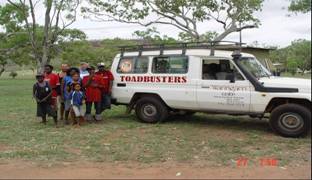
- Georgina and Ju Ju Wilson, Elaine Watts and Annie Fitzgerald, our Aboriginal Co-ordinators for organising the Aboriginal membership component of KTB.
- Local Community individuals and groups that have assisted towards the in-kind and financial expense of getting volunteers to the cane toad front
As a direct result of the 10 months of field work by the volunteer Kimberley Toad Busters a number of outcomes have been identified.
The Kimberley Toad Busters Wet Season Field Work Results in a Nutshell
imberley Toad Busters have now been able to collate and assess the field data from their wet season toad busting and provide the general observations listed below. It must be remembered that we do this as volunteers with what equipment and spare time we can muster, including this paper and presentation at the Brisbane forum. It is anticipated that the field data will provide us with some insight into how we plan our volunteer ‘field attack’ on the areas identified as ‘potential cane toad front line incursion’ threat areas. A synopsis of our wet season results follows. We:
- identified major cane toad breeding colonisation fronts west of the Victoria River
- identified cane toad ‘front-line incursions west of the cane toad breeding colonising fronts
- identified wet season cane toad movement patterns in a diverse range of habitat systems
- identified valuable wet season adult/tadpole and metamorph cane toad habitat information
- identified best humane methods of disposing of large numbers of cane toads when captured
- experimented with and identified ways of capturing Juvenile cane toads.
- experimented with and identified best methods of ‘capturing’ cane toad tadpoles and metamorphs
- identified best methods of identifying and ‘toad busting’ cane toad habitat systems during the day
- observed and recorded new and valuable scientific information on cane toad tadpole behaviour/sexing juveniles/metamorph behaviour/adult cane toad behaviour
- observed, identified and recorded cane toad impacts on native fauna such as whistling ducks/ kite hawks/ olive python and other reptile species/ burrowing frog/ freshwater crocodile
- recorded significant drops in numbers of first generation adult toads in areas being regularly ‘busted’ as well as a reduced number of tadpoles in areas being regularly busted
- experimented and recorded best field methods for ‘busting’ adult toads, eggs, tadpoles, metamorphs and juveniles both at night and during the day
- identified best wet season trapping methods for overnight catching and trapping
- identified best methods for ‘disposal’ of cane toads once euthanised to ensure least impact on native wildlife.
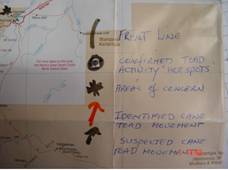 Wet Season Analysis!
Wet Season Analysis!
As a result of almost eleven months spent in the field by volunteers coordinated by the Kimberley Toad Busters, the collation of the field data has indicated a number of specific wet season and early dry season field results. Kimberley Toad Busters have roughly identified where the main cane toad ‘front line(s)’ is. In discussion and debriefing ‘field’ information sessions with CALM, at present the KTBs and CALM generally agree as follows:
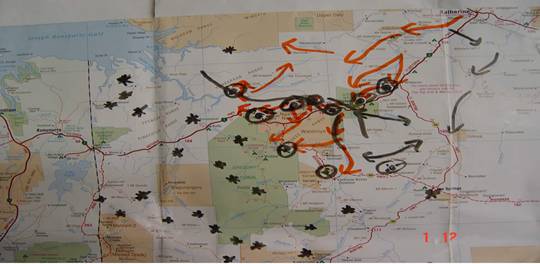
that there is no consistent 'front line' and that what we are seeing is a series of fronts (we have marked on the map only the three that are impacting on us immediately and are the areas we have mainly been working in). And that these fronts are still focused around the Victoria River . Will these successive front line invasions continue while food resources continue to be a problem? How many toads could one expect until diminishing food resources begin to play a role? This is difficult to determine without further more consistent monitoring. Despite the fact that the Victoria River Road House is now moving into its third year of cane toad occupation there still appears to be plenty of food resources to maintain breeding populations and successive 'waves';
- that 'major front line' populations represent all generations but also feature a dominance of juveniles becoming adults. Their main identifying feature is the dominance of large mature toads generally second and third generation, and the generally even mix of females and males of this size;
- we are identifying 'colonising' advance frontline movement from the main population fronts by the dominance of large male toads (13-15cm in size) found in a single area (with few or no females) and that they are all calling (an amazing experience when you encounter it for the first time). These generally comprise very large numbers and make up about 98% of the colonising population. Examples of this phenomenon were seen at Esplanade Walk (busted at Christmas and for two consecutive weekends). Brownies Creek over several weekends (only recently has the population mix changed and does this mean they have moved on or is it that we have wiped out the bulk of the adult male population?). Interestingly, when we first started work on Coolibah Station, the cane toad gender mix in the population (although all large and over a year old) was about even. While it is feasible to suggest that the male colonising front may have moved on, our volunteer toad busters working at Brownies Creek and the general area felt fairly confident they had ‘busted’ the main colonising population. We were also able to pinpoint dominant males calling along the Victoria River in two other locations between Coolibah Station and Brownies, although we were unable to get to them at the time;
- front line incursions have been identified as random and to some degree a result of 'accidental' movement (such as those found at Timber Creek) and probably due to both large male and gravid females being swept along the Victoria River and other flooded tributaries coming off the Victoria River. Although there appears to be a deliberate movement by adult toads along the upper reaches of the Victoria River ? Not being able to get into this area during the wet season means that we may have missed deliberate male colonising fronts moving against the flood? Until more recently we were still seeing the Victoria River as the main water highway but we feel the flooded periods may have now changed the dynamics of this movement. Hence the incursion fronts being found in Jasper, Kidman Springs, Moolooloo and Auvergne stations etc. This has also been facilitated by the movement along the Victoria Highway and other road systems such as the Buchanan while they were wet;
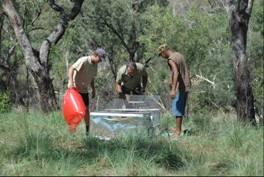 the Kimberley Toad Busters have concluded that maintaining trapping and toad busting (during the dry) in the main 'front' areas (and further east as well) are critical in containing as well as reducing successive 'waves' of adult toads into the problem incursion’ areas (figure 4). It is also agreed between Kimberley Toad Buster’s that it is critical that we also bust all the problem incursion fronts at the same time to reduce successful breeding and to take as many of the adult breeding toads from the system as we possibly can; and
the Kimberley Toad Busters have concluded that maintaining trapping and toad busting (during the dry) in the main 'front' areas (and further east as well) are critical in containing as well as reducing successive 'waves' of adult toads into the problem incursion’ areas (figure 4). It is also agreed between Kimberley Toad Buster’s that it is critical that we also bust all the problem incursion fronts at the same time to reduce successful breeding and to take as many of the adult breeding toads from the system as we possibly can; and - Kimberley Toad Buster's are working on a trapping strategy that gets traps into as many of the 'hotspots' and ‘incursion areas’ as possible, and to also maintain trapping in the 'front line' areas. We will continue to complement this with physical hand catching toad busting in areas that we have identified as major ‘front line’ and with areas that are well east behind the cane toad invasion waves. The more volunteers that we have the more we can do. The more recurrent funding we have, the more volunteers we can support in the field.
General Field Observations from the Front Line
The KTBs observations in the field include:
- colonising male toad fronts are distinctive and recognisable, and suggest that primarily only male toads move forward and once safely established begin ‘calling’ the mature females to join them. (Female adult toads, if present at all, were represented by less than 3% of the total population ‘busted’ in these colonising fronts);
- ‘incursion’ fronts (usually resulting from flood movement) seemed to be dominated by large and extremely gravid females (are they the better swimmers?).
- female toads at the end of the dry were observed to dominate creek systems and other ‘wetter’ areas, and were ‘busted’ ‘hibernating’ in areas that were frequented by cattle and buffalo;
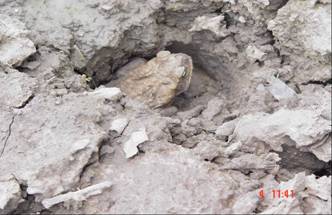 day time habitat systems of adult cane toads include buffalo hoof prints, grassy verges on dams and other still water bodies;
day time habitat systems of adult cane toads include buffalo hoof prints, grassy verges on dams and other still water bodies;
- metamorphs and juveniles were found in hoof prints, grassy shaded areas etc.;
- during the wet, males were seen to be moving in huge numbers ahead of the cane toad ‘front’ colonising areas, and then ‘sitting’ and ‘calling’. (Higher humidity and temperature readings on these nights indicate this might have some bearing on this movement and the insistence of the male call?);
- adult toads were seen to be swimming across large expanses of water as well as being able to ‘sub-merge’ for several minutes to avoid capture;
- Large Female toads were observed to ‘inflate’ when swimming across the Victoria River , suggesting they use this method to for more buoyancy? (is this why there are more females in ‘incursion’ fronts?).
- metamorphs were observed to move several hundred metres from water and to climb up into high, well watered escarpment areas;
- metamorphs were observed ‘hydrating’ in and on cow and buffalo dung, often 30 to 50 meters from water.
- Juveniles were observed, just after the wet, using buffalo hoof prints and deep cracked clays to ‘hide’ and ‘hydrate’ in during the day.
- cane toad egg transition to ‘tadpole’ appeared to be as little as 13 hours during the ‘hotter’ part of the wet. (This suggests that egg-to tadpole-metamorph-may depend on environment more than we have preciously estimated?);
 native frogs, in the initial period of the cane toad arriving seemed able to work out a compromise. Several areas ‘busted’ by volunteers indicated that water holes were divided into separate areas, with cane toads dominating one and native frog species dominating another. It was observed by Kimberley Toad Busters that this ‘situation’ only sustained for the first period of ‘toad’ colonisation (for 3-5 weeks);
native frogs, in the initial period of the cane toad arriving seemed able to work out a compromise. Several areas ‘busted’ by volunteers indicated that water holes were divided into separate areas, with cane toads dominating one and native frog species dominating another. It was observed by Kimberley Toad Busters that this ‘situation’ only sustained for the first period of ‘toad’ colonisation (for 3-5 weeks);
- quantities of ‘bait’ fish were observed ‘dead’ on the surface of some creek systems containing cane toad eggs and tadpoles;
- within a few hours of cane toad eggs being deposited in a dam or other small isolated water systems (such as gravel pits), native tadpoles were often found dead on the surface of the water. Whistling ducks were also observed to die after ingesting tadpoles.
- as creeks and waterholes began to dry out in areas where cane toad ‘incusions’ had gained a’ foothold’, many had leeches and tics attached to various parts of the cane toads anatomy. In all instances where leeches had attached themselves the toads appeared to be in very poor and dehydrated states.
CONCLUSIONS
It has been a little over one year since the Kununurra community banded together, and participated in the Kununurra cane toad forum.
In this time, huge achievements have been made in educating the local community about the cane toad threat, its habitats and behaviour; developing strategies to fight their advance in the coming dry season; and implementing infrastructure and resources to put the fight to the next level.
The end of last year’s dry season gave the toad busters their first experience with the cane toad battle. During this period many of us were able to explore first hand the area and topography where this unique desert battle will be fought in the coming dry season. This experience provided us our own first hand information as to the behaviour of the toads; develop ideas about weapons we could use in our arsenal, such as traps and nets; equipment needed such as vehicles, radios, generators and camping gear; the ideal safety equipment for our volunteers; and the myriad number of other sundry items needed to wage a successful campaign.
The last wet season has proved invaluable as a lead up to the coming fight. At the front line, tens of thousands of breeding toads were disposed of, and hundreds of thousands, perhaps millions of eggs were prevented from being laid ahead of the cane toad front. Likely invasion routes have been plotted, potential specific cane toad water course and water hole habitats have been identified, our strategies have been further refined, equipment procured and funding secured.
Through the work in the last dry season and the recent wet season many valuable working and education relationships have been established and solidified with the KTBs. These include with land holders such as local Aboriginal groups; Federal departments such as the DEH and the Defence Forces; State and Territory governments through WA CALM and the NT Parks and Wildlife; local government through SWEK; NT pastoralists; NT aboriginal communities; NT and WA and NT tourist operators.
The KTBs are now in a position to begin what we believe to be the largest, best equipped and coordinated sustainable field on the ground campaign to stop or at worst significantly slow the advance of the cane toad in Australia ’s history.
The success of our campaign to date is the result of the hard work and dedication of the Kimberley community, especially Kununurra. This whole effort started in Kununurra and has largely been facilitated by local residents. It has brought the community together in a way that no other single project has before. Government departments, local business, shire, indigenous groups, community members of all persuasions are all working together in the field for a common purpose. This paper is a celebration of their efforts and a hope for their future and continued success.
Postscript: Word of Caution
The real strength of this volunteer regional campaign is that it is being planned, directed and coordinated from the local area i.e. Kununurra. We are all part of the effort; every individual has ownership and makes their contribution in close liaison with the KTB Board and KTB field coordinators and with CALM. Any attempt that succeeds in removing any part of the campaign decision making or the field strategy planning away from the Kununurra community groups and the KTBs will result in a loss of ownership felt amongst the campaigners. This is likely to lead to a significant loss of the volunteer energy required for our success. If that happens, the Kimberley ecosystems and the fauna and flora they support are more likely to be diminished and perhaps even lost to this noxious menace.
IF EVERYONE BECAME A TOAD BUSTER.
THE TOADS WOULD BE BUSTED!
kimberleyspecialists@westnet.com.au
Lee or Dean on 91682576
Or contact Sarah Brett 0407691229
